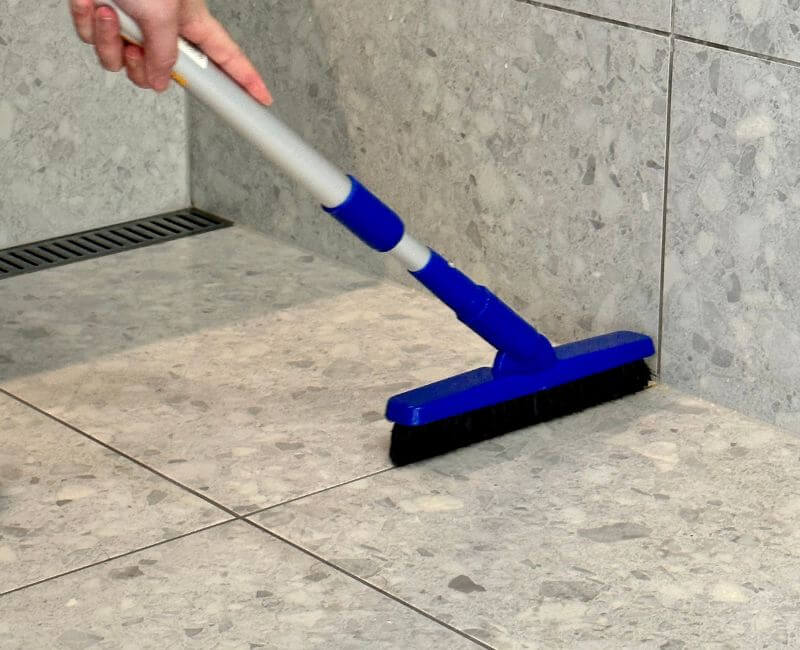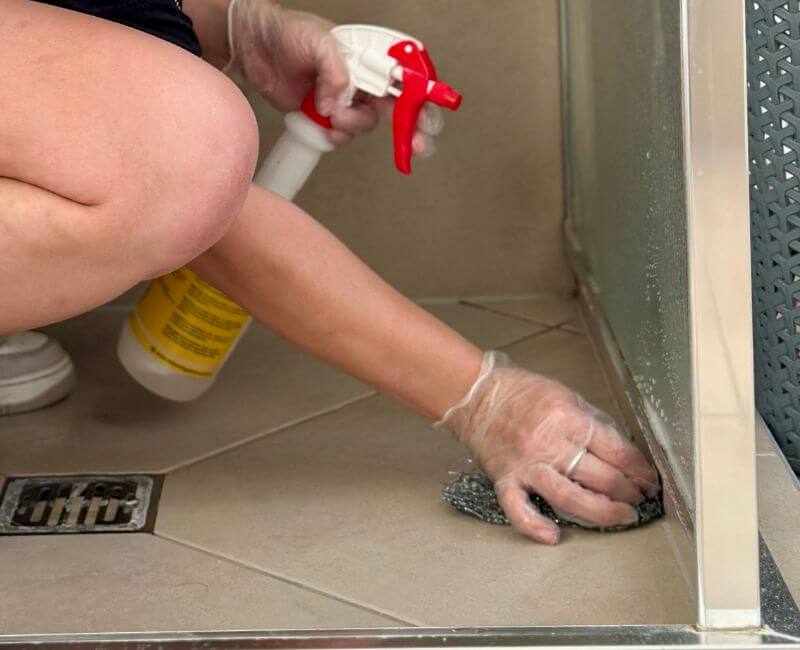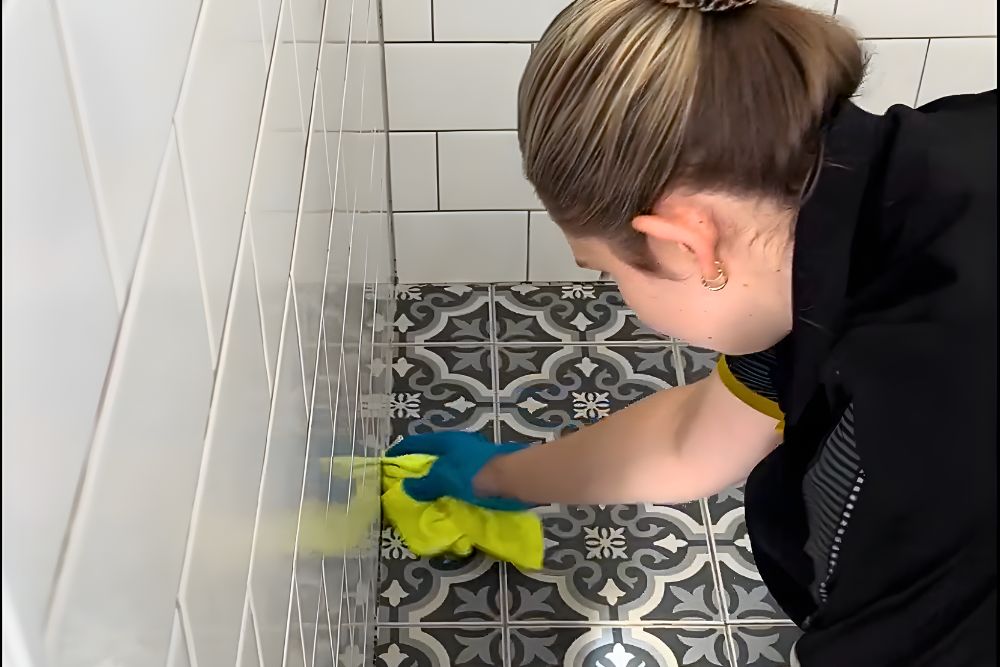There’s nothing better than squeaky clean floor tiles, until you spot those annoying rust stains.
Rust marks can be stubborn, so the key is to treat them right away. But before you grab any cleaning product, make sure that it’s safe for your floor first.
For non-porous tiles like ceramic or porcelain, you can use natural rust-fighting ingredients such as citric acid or vinegar.
On the other hand, porous tiles such as marble or terracotta are more delicate. On these, opt for gentler methods like baking soda or a pH-neutral rust remover.
Get ready to say goodbye to a rusty, dirty floor! In this blog, we’ll explain how to remove rust stains from tiles so you can get them looking spotless again.
Before Cleaning | Cleaning Methods that Work on Rust | Preventing Rust Stains
What Causes Rust Stains on Tiles?
Rust is caused by a chemical reaction. When iron comes into contact with oxygen and water, it oxidises and creates iron oxide (aka rust!).
That’s why rust is more common in humid parts of the home, like the bathroom, shower, and kitchen. And unfortunately, floor tiles are among the first to get stained.
While tiles are not usually made of metal, rust can transfer from nearby metal objects or fixtures. Common culprits include:
- Floor-standing toilet paper holders or metal storage racks
- Leaky metal pipes or fittings that drip onto tiles
- Metal furniture or decor resting on damp tiles
- Cans or razors left on bathroom floors
Hard water with high iron content can also leave behind rust deposits over time.
Before Cleaning Rust Stains From Tiles

Before you start cleaning rust off tiles, take a moment to check the tile’s material and prepare the supplies you’ll need!
Consider the tile material
To avoid damaging your tiles, it’s important to know what they’re made of. This helps you choose the safest and most effective rust removal method.
Non-porous tiles like ceramic, porcelain, and glass are generally less prone to rust stains. They’re durable and water-resistant, which makes them easier to clean.
These tiles can also handle plenty of cleaning products, but take care not to use harsh chemicals that can wear down the protective layer.
On the other hand, porous tiles — such as natural stone, terracotta, and wood — are more delicate. Rust can seep into the material, making the stain harder to clean.
To remove rust from these surfaces, use an appropriate cleaner that’s labelled safe for your tiles.
For example, natural stone and terracotta (especially if they’re unsealed!) can get permanently etched or stained by highly acidic or highly alkaline cleaners.
That means you should avoid citric acid, lemon juice, or vinegar on these tiles — use pH-neutral solutions instead.
Meanwhile, wooden tiles can warp or swell when exposed to too much moisture, so use minimal water when cleaning.
Use the right cleaning materials
When removing rust from tiles, always use gentle, non-abrasive cleaning tools. Soft sponges, microfibre cloths, or an old, soft-bristle toothbrush work best.
Do not use stiff brushes, steel wool, or rough scouring pads that can scratch or damage the tile surface permanently.
As for cleaning solutions, start with mild options (e.g. dish soap, baking soda) before trying stronger ones.
If you’re unsure how a product will react, test it first on a small, hidden area to check for discolouration or surface damage.
Also, never mix cleaning ingredients such as vinegar and hydrogen peroxide or vinegar and bleach. These can create harmful chemical reactions!
If you’re trying out multiple cleaning methods, rinse off the first one thoroughly before moving on to the next.
How To Remove Rust From Tiles

Rust stains can be tricky to clean, especially if they’ve been sitting on your tiles for a while. The sooner you treat them, the easier they’ll be to lift!
If the rust has set in, you might need to try a few different methods to make them spotless again.
Make sure the area is well-ventilated, especially when removing rust stains from bathroom tiles. Open a window or turn on the exhaust fan.
And don’t forget: wear protective gear like rubber gloves and a mask to keep yourself safe while cleaning.
Option 1. Dish soap
Suitable for: Porous and non-porous tiles
To remove rust stains from porous tiles like natural stone, mild dishwashing liquid can help, particularly for new marks!
Combine a few drops of dish soap with warm water in a bowl.
For larger stains, fill a bucket with warm water plus 1–2 tablespoons of dish soap, and mix well.
Dampen a microfibre cloth with the solution, and use that to gently scrub the stained area.
For ceramic tiles and other non-porous materials, you can apply undiluted dish soap directly onto the stain.
Let it sit for 5–10 minutes, then use an old toothbrush to lightly scrub the stain in circular motions.
Once the rust is gone, rinse everything with a clean, damp cloth and dry thoroughly to prevent water marks.
Option 2. Baking soda
Suitable for: Porous and non-porous tiles
Baking soda is a mildly abrasive cleaner that can help lift rust stains from tile surfaces.
Combine 3 parts baking soda and 1 part water to create a thick paste. Spread it over the rust stain, making sure it covers the entire area.
Wait 15–20 minutes to give the baking soda enough time to work. Then, use a soft, damp sponge to rub the stain.
Once the mark is gone, wipe off the remaining baking soda with a clean, damp cloth. Dry the surface with a fresh rag for a spotless finish.
TIP: Baking soda and water didn’t work? You can mix equal parts baking soda and dish soap to make a stronger stain remover!
Option 3. Citric acid powder
Suitable for: Non-porous tiles
Citric acid is one of the best tile rust removers you can use!
It’s the same acid found in citrus fruits like lemons and oranges. But for cleaning, it’s a lot easier to use the powdered form sold online or in grocery stores.
You can use it on non-porous tiles like ceramic, glass, and porcelain.
For small or new rust stains, mix 1 part citric acid powder with 10 parts water in a spray bottle.
For larger or tougher stains, use a more concentrated citric acid solution. You can also use a thin citric acid paste with a little salt.
Apply it onto the stain, and let it sit for 15–20 minutes. Then, gently scrub the rust stain in circular motions until it’s gone.
Once your tiles are spotless, rinse everything with a fresh, damp cloth and thoroughly wipe the area dry.
Option 4. White vinegar
Suitable for: Non-porous tiles
So, does vinegar really remove rust from tiles? Yes, it does!
White vinegar contains acetic acid, which can dissolve rust marks on ceramic and porcelain tiles.
For light rust stains, mix equal parts white vinegar and water in a spray bottle. For older or stubborn stains, use undiluted vinegar instead.
Spritz the solution directly onto the rust marks. For larger stains, you can also lay a vinegar-soaked rag over the area.
Let the vinegar sit for at least 30 minutes (or overnight for tougher stains), then gently scrub with an old toothbrush.
When you’re done, rinse the floor with a clean, damp cloth, and dry thoroughly.
TIP: If regular vinegar didn’t work, you can also use cleaning vinegar, which has a higher concentration!
Option 5. Hydrogen peroxide
Suitable for: Non-porous tiles and light-coloured stone tiles
Hydrogen peroxide is another effective way to remove rust stains on tiles.
A 3% hydrogen peroxide solution is safe for non-porous surfaces like ceramic, glass, and porcelain. It can also work on light-coloured natural stone.
However, note that it can have a bleaching effect on dark-coloured stone, terracotta, and wood, especially if the surface is unsealed.
To use, apply 3% hydrogen peroxide directly onto the rust stain. Let it sit for 10–15 minutes, then scrub lightly.
If that doesn’t work, you can use a paste made from equal parts hydrogen peroxide and baking soda.
Spread it over the affected area, wait a few minutes, then lightly brush the stain again.
After removing the rust, mop up any residue with a fresh, damp towel, and don’t forget to wipe the surface dry.
Option 6. Specialised rust remover
Tried several rust removal methods for your tiles but nothing worked? It might be time to use a specialised rust remover!
Just be sure to read the label first to check if it’s compatible with your tile material.
For example, pH-neutral rust removers are best for natural stone and terracotta, while wooden surfaces need a wood-safe formula.
If you’re unsure, spot test the product on a small, hidden area first to make sure that it’s safe for your tiles.
Always follow the manufacturer’s instructions carefully for the best results.
How to Prevent Rust Stains on Tiles

Removing rust from tiles in the bathroom or shower can be quite tricky. The best approach is to prevent stains in the first place by keeping your tiles clean.
Aim to keep your floor tiles dry by wiping them after using your shower or bathroom.
Clean any rust stains you see right away, both on the floor and on metal furnishings, as new marks are much easier to remove.
Also, regularly inspect taps, pipes, and other fittings for leaks, and have them fixed quickly before they start causing rust on the tiles.
It’s also best to avoid leaving metal objects directly on the floor. You can store them in shelves or trays instead.
And if you’re short on time, you can always book a professional home cleaner!
They can deep clean and organise your bathroom (and the rest of your home) to keep everything fresh and sparkling.
FAQs About Removing Rust Stains on Tiles
Looking for other ways to remove those stubborn rust stains on your tiles?
Check out these Q&As to find out which products work and which to avoid!
Does CLR remove rust from tiles?
Yes, CLR (Calcium, Lime, and Rust Remover) can remove rust from tiles, but it’s safe only for non-porous tiles like ceramic, glass, and porcelain.
Do not use CLR on natural stone, wood, or any porous surface. The strong acids in CLR can permanently dull or etch the finish of these tiles!
Can WD-40 remove rust from tiles?
Yes, WD-40 contains oils and solvents that can loosen rust stains on tiles. It’s generally safe to use on non-porous tiles like ceramic or porcelain.
Avoid using it on natural stone and other porous materials, since the oils can seep in and discolour the finish!
Spray a small amount of WD-40 directly onto the rust stain, let it sit for a few minutes, then gently scrub with an old toothbrush.
Once the rust is gone, wipe off the remaining WD-40 with a cloth dampened with soapy water.
Go over the area again with another cloth dampened in clean water to remove all oily residue. Finish by drying the tiles thoroughly.
Does bleach remove rust stains?
No, you should never use bleach to remove rust stains on tiles (or any surface) because it can make the rust permanent.
The chlorine in bleach reacts with iron, which causes further oxidation. This deepens the stain instead of lifting it!
Can kerosene remove rust stains on tiles?
Kerosene can sometimes lift rust stains on tiles, but it’s not the safest option!
This petroleum-based solvent can leave behind a strong and hazardous smell, which may cause headaches and respiratory problems when inhaled.
Kerosene is also flammable, so it’s not advisable for indoor use or for enclosed spaces like bathrooms.
Instead of kerosene, use non-toxic solutions like citric acid or vinegar to get rid of rust stains on tiles.

